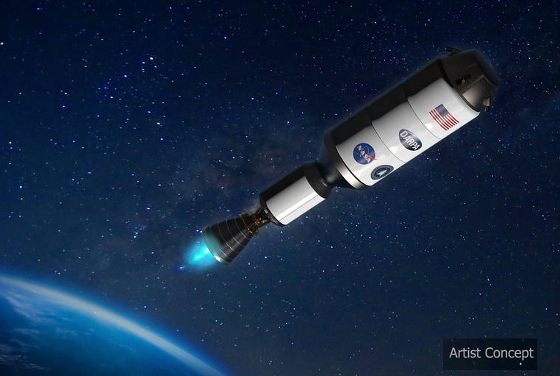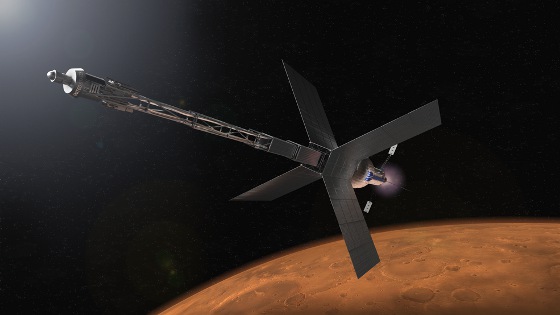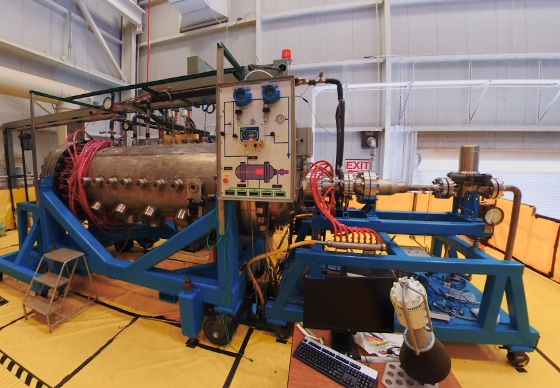 |
| March 21, 2023 | Volume 19 Issue 11 |
Designfax weekly eMagazine
Archives
Partners
Manufacturing Center
Product Spotlight
Modern Applications News
Metalworking Ideas For
Today's Job Shops
Tooling and Production
Strategies for large
metalworking plants
NASA and DARPA developing nuclear rocket engine for future Mars missions

Artist concept of Demonstration for Rocket to Agile Cislunar Operations (DRACO) spacecraft, which will demonstrate a nuclear thermal rocket engine. Nuclear thermal propulsion technology could be used for future NASA crewed missions to Mars. [Credit: DARPA]
NASA and the Defense Advanced Research Projects Agency (DARPA) announced Jan. 24, 2023, a collaboration to demonstrate a nuclear thermal rocket engine in space, an enabling capability for NASA crewed missions to Mars.
NASA and DARPA will partner on the Demonstration Rocket for Agile Cislunar Operations, or DRACO, program. The non-reimbursable agreement, designed to benefit both agencies, outlines roles, responsibilities, and processes aimed at speeding up development efforts.
"NASA will work with our long-term partner, DARPA, to develop and demonstrate advanced nuclear thermal propulsion technology as soon as 2027. With the help of this new technology, astronauts could journey to and from deep space faster than ever -- a major capability to prepare for crewed missions to Mars," said NASA Administrator Bill Nelson.
Using a nuclear thermal rocket allows for faster transit time, reducing risk for astronauts. Reducing transit time is a key component for human missions to Mars, as longer trips require more supplies and more robust systems. Maturing faster, more efficient transportation technology will help NASA meet its Moon to Mars Objectives.
To date, only robotic explorers have traveled to Mars, without the need for returning to Earth. Waiting for optimal planetary alignment for the return trip would require astronauts to loiter at Mars for more than a year, stretching the round-trip mission to more than three years.
NASA's goal is to minimize the time the crew travels between Earth and Mars to as close to two years as is practical. Space nuclear propulsion systems could enable shorter total mission times and provide enhanced flexibility and efficiency for mission designers.

Illustration of a Mars transit habitat and nuclear propulsion system that could one day take astronauts to Mars. [Credit: NASA]
Other benefits to space travel include increased science payload capacity and higher power for instrumentation and communication. In a nuclear thermal rocket engine, a fission reactor is used to generate extremely high temperatures. The engine transfers the heat produced by the reactor to a liquid propellant, which is expanded and exhausted through a nozzle to propel the spacecraft. Nuclear thermal rockets can be three or more times more efficient than conventional chemical propulsion.
Under the agreement, NASA's Space Technology Mission Directorate (STMD) will lead technical development of the nuclear thermal engine to be integrated with DARPA's experimental spacecraft. DARPA is acting as the contracting authority for the development of the entire stage and the engine, which includes the reactor. DARPA will lead the overall program including rocket systems integration and procurement, approvals, scheduling, and security; cover safety and liability; and ensure overall assembly and integration of the engine with the spacecraft. Over the course of the development, NASA and DARPA will collaborate on assembly of the engine before the in-space demonstration as early as 2027.
"DARPA and NASA have a long history of fruitful collaboration in advancing technologies for our respective goals, from the Saturn V rocket that took humans to the Moon for the first time to robotic servicing and refueling of satellites," said Dr. Stefanie Tompkins, director, DARPA. "The space domain is critical to modern commerce, scientific discovery, and national security. The ability to accomplish leap-ahead advances in space technology through the DRACO nuclear thermal rocket program will be essential for more efficiently and quickly transporting material to the Moon and, eventually, people to Mars."
The last nuclear thermal rocket engine tests conducted by the United States occurred more than 50 years ago under NASA's Nuclear Engine for Rocket Vehicle Application and Rover projects.
"With this collaboration, we will leverage our expertise gained from many previous space nuclear power and propulsion projects," said Jim Reuter, associate administrator for STMD. "Recent aerospace materials and engineering advancements are enabling a new era for space nuclear technology, and this flight demonstration will be a major achievement toward establishing a space transportation capability for an Earth-Moon economy."
NASA, the Department of Energy (DOE), and industry are also developing advanced space nuclear technologies for multiple initiatives to harness power for space exploration. Through NASA's Fission Surface Power project, DOE awarded three commercial design efforts to develop nuclear power plant concepts that could be used on the surface of the Moon and, later, Mars.
NASA and DOE are working another commercial design effort to advance higher temperature fission fuels and reactor designs as part of a nuclear thermal propulsion engine. These design efforts are still under development to support a longer-range goal for increased engine performance and will not be used for the DRACO engine.
NASA and DOE efforts
NASA's Marshall Space Flight Center in Huntsville, AL, leads the agency's space nuclear propulsion project in partnership with a DOE team that includes scientists and engineers from Idaho National Laboratory, Los Alamos National Laboratory, and Oak Ridge National Laboratory. STMD's Technology Demonstration Missions program funds the technology development.
Nuclear electric propulsion builds on NASA's work maturing solar electric propulsion thrusters and systems for Artemis, as well as the development of fission power for the lunar surface. Significant investment has also been made in relevant fuel and reactor technologies for small, terrestrial reactors that could be adapted to space reactors to power electric propulsion. The U.S. government's aim to establish a fuel fabrication capability has a range of applications, including nuclear propulsion and fission surface power.

The Nuclear Thermal Rocket Element Environmental Simulator at NASA's Marshall Space Flight Center in Huntsville, AL, tests nuclear rocket fuel prototypes using non-nuclear heating instead of fission. [Credit: NASA/Mick Speer]
NASA, in partnership with DOE, is developing and testing new fuels that use low-enriched uranium for space applications to see how they perform under the extreme thermal and radiation environments needed for nuclear thermal propulsion. NASA is working closely with DOE, industry, and universities to put fuel samples in research reactors at Idaho National Laboratory's Transient Reactor Test (TREAT) facility and the Massachusetts Institute of Technology Nuclear Reactor Laboratory for nuclear testing. The team is also performing non-nuclear testing in simulated reactors at Marshall test facilities.
"The reactor underpinning a nuclear thermal propulsion system is a significant technical challenge due to the very high operating temperatures needed to meet the propulsion performance goals," explained Anthony Calomino, NASA's nuclear technology portfolio lead within STMD.
While most of the engine operates at modest temperatures, materials in direct contact with the reactor fuel must be able to survive temperatures above 4,600 F. NASA and DOE have been working with industry on a viable approach, and industry is now developing preliminary designs to meet this challenge.
Read more NASA articles about Moon to Mars missions at nasa.gov/topics/moon-to-marsreports.
Sources: Compiled from NASA reports by Sarah Frazier and Clare Skelly, NASA Headquarters, Washington, and Tabatha Thompson, DARPA.
Published March 2023
Rate this article
View our terms of use and privacy policy
